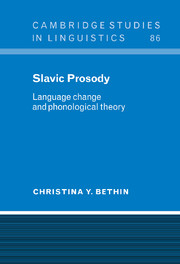Book contents
2 - Beyond the syllable: prominence relations
Published online by Cambridge University Press: 07 September 2010
Summary
Background
Slavic languages exhibit a variety of prosodic systems, though they may be generally divided into stress and pitch accent languages. In some, prominence is expressed by free stress, as in Belarusian, Ukrainian, Bulgarian, Russian, Northern Kashubian (Slovincian); in others, stress is fixed, as in Czech, Polish, Slovak, Southern Kashubian, Upper Sorbian, Macedonian; and stress in Polabian may be predictable. Lower Sorbian has initial stress and a strong secondary stress on the penultimate syllable. The Slavic languages with pitch accent have only one main pitch accent per phonological word (unlike contour tone languages). Serbian, Croatian, and Slovene are of this type and the pitch accent is often subject to certain quantitative or positional restrictions. Transitional dialects tend to show transitional prosodic features, e.g., some southwestern Ukrainian dialects have fixed stress; eastern and parts of central Macedonia have different types of non-fixed stress patterns.
In this chapter I demonstrate that although there was one accent per phonological word in Common Slavic (CS), Late Common Slavic (LCS) had a bisyllabic norm for the expression of prosody. First I show that a major change in Slavic was the shift from a bimoraic to a bisyllabic prosodic grouping (2.2). This bisyllabic norm was more than a phonetic requirement for the expression of pitch accent; it was a phonologically significant metrical grouping. Many phonological changes in LCS, including the distribution of quantity, were circumscribed by it (2.3).
- Type
- Chapter
- Information
- Slavic ProsodyLanguage Change and Phonological Theory, pp. 112 - 187Publisher: Cambridge University PressPrint publication year: 1998



